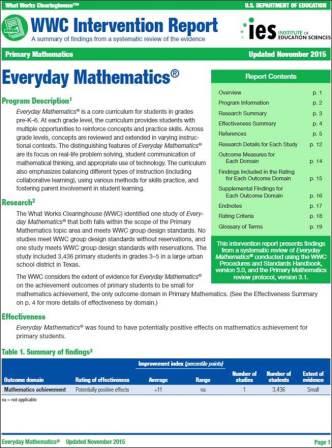By Joy Lesnick, Acting Commissioner, NCEE
The Every Student Succeeds Act (ESSA), the new federal education law, requires education leaders to take research evidence into account when choosing interventions or approaches. ESSA defines three “tiers” of evidence—strong, moderate, and promising—based on the type and quality of study that was done and its findings.
.jpg)
Are the ESSA definitions the same as those of Institute of Education Sciences’ What Works Clearinghouse (WWC)? Not exactly. ESSA definitions and WWC standards are more like cousins than twins.
Like ESSA, the WWC has three ratings for individual studies – meets standards without reservations, meets standards with reservations, and does not meet standards. The WWC uses a second set of terms to summarize the results of all studies conducted on a particular intervention. The distinction between one study and many studies is important, as I will explain below.
You may be wondering: now that ESSA is the law of the land, should the WWC revise its standards and ratings to reflect the tiers and terminology described in ESSA? Wouldn’t the benefit of making things nice and tidy between the two sets of definitions outweigh any drawbacks?
The short answer is no.
The most basic reason is that the WWC’s standards come from a decision-making process that is based in science and vetted through scholarly peer review, all protected by the independent, non-partisan status of the Institute of Education Sciences (IES). This fact is central to the credibility of the WWC’s work. We like to think of the WWC standards as an anchor representing the best knowledge in the field for determining whether a study has been designed and executed well, and how much confidence we should have in its findings.
WWC Standards Reflect the Most Current Scientific Knowledge – and are Always Evolving
WWC standards were developed by a national panel of research experts. After nearly two years of meetings, these experts came to a consensus about what a research study must demonstrate to give us confidence that an intervention caused the observed changes in student outcomes.
Since the first WWC standards were developed over a decade ago, there have been many methodological and conceptual advances in education research. The good news is that the WWC is designed to keep up with these changes in science. As science has evolved, the WWC standards have evolved, too.
One example is the WWC’s standards for reviewing regression discontinuity (RD) design studies. The first version of RD standards was developed by a panel of experts in 2012. Since then, the science about RD studies has made so much progress that the WWC recently convened another panel of experts to update the RD standards. The new RD standards are now on the WWC website to solicit scholarly comment.

When it Comes to Evidence, More is Better
The evidence tiers in ESSA set a minimum bar, based on one study, to encourage states, districts, and schools to incorporate evidence in their decision making. This is a very important step in the right direction. But a one-study minimum bar is not as comprehensive as the WWC’s approach.
In science, the collective body of knowledge on a topic is always better than the result of a single study or observation. This is why the primary function of the WWC is to conduct systematic reviews of all of the studies on a program, policy, practice, or approach (the results of which are published in Intervention Reports like the one pictured here).
The results of individual studies are important clues toward learning what works. But multiple studies, in different contexts, with different groups of teachers and students, in different states, and with different real-world implementation challenges tell us much more about how well a program, policy, practice or approach works. And that, really, is what we’re trying to find out.
An Improved WWC Search Tool and Ongoing Support for States and Districts
One area where WWC will make changes is in how users find studies that have certain characteristics described in ESSA’s evidence tiers. For the past 16 months, the WWC team has been hard at work behind the scenes to develop, code, and user-test a dramatically improved Find What Works tool. We expect to release this tool, along with other changes to the WWC website, in fall 2016. (More on that in another post, but the picture below offers a sneak preview!)
These changes should further increase the utility of the WWC website, which already gets more than 300,000 hits each month and offers products that are downloaded hundreds of thousands of times each year.
We know that providing information on a website about evidence from rigorous research is just a first step. States and districts may need additional, customized support to incorporate evidence into their decision-making processes in ways that are much deeper than a cursory check-box approach.
+2.jpg)
To meet that need, other IES programs are ready to help. For example, IES supports 10 Regional Educational Laboratories (RELs) that provide states and districts with technical support for using, interpreting, and applying research. At least two researchers at every REL are certified as WWC reviewers (meaning they have in-depth knowledge of the WWC standards and how the standards are applied), and every REL has existing relationships with states and districts across the nation and outlying regions. Because the RELs are charged with meeting the needs of their regions, every chief state school officer (or designee) sits on a REL Governing Board, which determines the annual priorities of the REL in that area.
As states prioritize their needs and identify ways to incorporate evidence in their decisions according to the new law, the WWC database of reviewed studies will provide the information they need, and the RELs will be ready to help them use that information in meaningful ways.